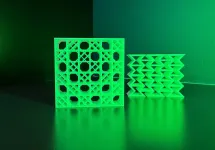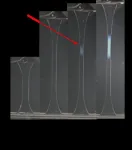Novel photochromic glass can store rewritable 3D patterns
2025-02-26
(Press-News.org) For decades researchers have been exploring how to store data in glass because of its potential to hold information for a long time — eons — without applying power. A special type of glass that changes color in different wavelengths of light, called photochromic glass, holds promise for stable, reusable data storage. Now, researchers have developed a doped photochromic glass that has the potential to store rewritable data indefinitely, according to research published in ACS Energy Letters.
Certain types of eyeglasses get darker when exposed to wavelengths of light emitted by the sun and then shift back to a colorless lens indoors when no longer exposed to those light waves through a process called reversible photochromism. Likewise, other types of photochromic glass can switch color in response to different wavelengths of light, making this material attractive as an inexpensive and stable platform for storing vast amounts of information in a small space. But the challenge in using photochromic glass for data storage involves not only writing information into the glass but also erasing and rewriting it ad infinitum. Now, Jiayan Liao, Ji Zhou, Zhengwen Yang and a multidisciplinary team have made progress toward this goal by creating reversible, tunable patterns on photochromic gallium silicate glass.
The team first designed gallium silicate glass modified with magnesium and terbium ions by using a process called doped direct 3D lithography. Liao and the team used a green 532-nanometer (nm)-wavelength laser to inscribe 3D patterns into tiny slabs of the doped glass. The intricate patterns, randomly chosen dots, symbols, QR codes, geometric prisms, and even a bird, appear purple in the transparent glass, which turns other colors when excited at precise wavelengths. Terbium luminesces green when excited by a deep violet 376-nm laser, and magnesium luminesces red in the presence of violet light at 417 nm. Then, to fully erase the patterns without changing the structure of the glass, the team applied heat at 1022 degrees Fahrenheit (550 degrees Celsius) for 25 minutes.
Furthermore, the researchers consider the use of magnesium and terbium groundbreaking for their abilities to luminesce at distinctly different wavelengths, which makes it possible to get a tunable, multicolor readout of 3D patterns from a single material. The new approach could be used for high-capacity, stable 3D optical memory storage and encryption in industrial, academic and military applications.
The authors acknowledge financial support from the National Natural Science Foundation of China, Science and Technology Project of Southwest Joint Graduate School of Yunnan Province, Key Project of the National Natural Science Foundation of China-Yunnan Joint Fund, National Natural Science Foundation of High-end Foreign Experts Introduction Plan, Academician Expert Workstation of Cherkasova Tatiana in Yunnan Province, Yunnan Province Major Science and Technology Special Plan, Preparation and Property Control of Luminescent Materials and Application in Plateau Agriculture, University of Technology Sydney Chancellor’s Research Fellowship Program, and the National Health and Medical Research Council.
The paper’s abstract will be available on Feb. 26 at 8 a.m. Eastern time here: http://pubs.acs.org/doi/abs/10.1021/acsenergylett.5c00024
###
The American Chemical Society (ACS) is a nonprofit organization founded in 1876 and chartered by the U.S. Congress. ACS is committed to improving all lives through the transforming power of chemistry. Its mission is to advance scientific knowledge, empower a global community and champion scientific integrity, and its vision is a world built on science. The Society is a global leader in promoting excellence in science education and providing access to chemistry-related information and research through its multiple research solutions, peer-reviewed journals, scientific conferences, e-books and weekly news periodical Chemical & Engineering News. ACS journals are among the most cited, most trusted and most read within the scientific literature; however, ACS itself does not conduct chemical research. As a leader in scientific information solutions, its CAS division partners with global innovators to accelerate breakthroughs by curating, connecting and analyzing the world’s scientific knowledge. ACS’ main offices are in Washington, D.C., and Columbus, Ohio.
Registered journalists can subscribe to the ACS journalist news portal on EurekAlert! to access embargoed and public science press releases. For media inquiries, contact newsroom@acs.org.
Note: ACS does not conduct research but publishes and publicizes peer-reviewed scientific studies.
Follow us: Facebook | LinkedIn | Instagram
END
ELSE PRESS RELEASES FROM THIS DATE:
2025-02-26
Inspired by the humble deep-sea sponge, RMIT University engineers have developed a new material with remarkable compressive strength and stiffness that could improve architectural and product designs.
The double lattice design was inspired by the intricate skeleton of a deep-sea sponge known as Venus' flower basket, which lives in the Pacific Ocean.
Lead author of the latest RMIT study into the structure, Dr Jiaming Ma, said extensive testing and optimisation revealed the pattern's impressive combination of stiffness and strength, mixed with an ability to contract when compressed.
It’s this last aspect – known as auxetic behaviour – ...
2025-02-26
While we are remarkably capable of generating our own goals, beginning with child’s play and continuing into adulthood, we don’t yet have computer models for understanding this human ability.
However, a team of New York University scientists has now created a computer model that can represent and generate human-like goals by learning from how people create games. The work, reported in the journal Nature Machine Intelligence, could lead to AI systems that better understand human intentions and more faithfully model ...
2025-02-26
A pioneering study has revealed new insights into the role of gastric bacteria in stomach cancer development that could pave the way for a more effective treatment of pre-cancer according to a study published today in Helicobacter.
The Royal Society and Cancer Research UK-funded research led by Dr Amanda Rossiter-Pearson at the University of Birmingham identified a crucial interaction between Helicobacter pylori and non-H. pylori bacteria in the pre-cancerous stage of gastric cancer.
Gastric cancer is the fourth ...
2025-02-26
Anemonefish, sometimes called clownfish, have been popular attractions in aquariums ever since Disney’s animated film Finding Nemo arrived in cinemas in 2003. Living symbiotically with sea anemones that shelter them from predators, the fish drive away organisms that nibble at their hosts. Anemonefish have also shown they will provide their hosts with the food given to them by humans, but does this happen in the wild?
An Osaka Metropolitan University Graduate School of Science team led by PhD student Yuya Kobayashi and Professor Satoshi Awata found evidence of this feeding behavior during field experiments. ...
2025-02-26
A team of researchers from the University of Oxford, in collaboration with Thames Valley Police, the National Crime Agency, the John Radcliffe Hospital, Lurtis Ltd. and Cardiff University, has developed an advanced physics-based AI-driven tool to aid the forensic investigation of traumatic brain injuries (TBI).
The study, published today (26 Feb) in Communications Engineering, introduces a mechanics-informed machine learning framework to help police and forensic teams accurately predict TBI outcomes based on documented assault scenarios.
TBI is a critical public health issue, with severe and long-term neurological consequences. In forensic investigations, determining ...
2025-02-26
CAMBRIDGE, MA -- About 60 percent of all cancer patients in the United States receive radiation therapy as part of their treatment. However, this radiation can have severe side effects that often end up being too difficult for patients to tolerate.
Drawing inspiration from a tiny organism that can withstand huge amounts of radiation, researchers at MIT, Brigham and Women’s Hospital, and the University of Iowa have developed a new strategy that may protect patients from this kind of damage. Their approach makes use of a protein from tardigrades, often also called “water bears,” which are usually less than a millimeter in ...
2025-02-26
New double network hydrogel technology features automated self-strengthening that rapidly activates upon deformation of its polymer network.
Hydrogels are soft materials consisting of polymer networks and water. They are permeable to substances smaller than their network mesh size and have applications in biomaterials, contact lenses, soft robots, and more. At the molecular level, the cleavage of chemical bonds causes a material to become mechanically weaker and can lead to its destruction. Mechanochemically ...
2025-02-26
The symptoms of schizophrenia vary greatly from person to person. A new study shows how these differences manifest themselves in the structure of the brain.
Schizophrenia is a complex mental health condition that affects perception, thought and emotions. This complexity is reflected in the individual manifestations of the disease: for some patients, perceptual disturbances are the main problem, while for others, cognitive impairments are more prevalent. “In this sense, there is not one schizophrenia, but many, each with different neurobiological profiles,” says Wolfgang Omlor, first author of the study and senior physician at the University Hospital of Psychiatry ...
2025-02-26
Continuous Glucose Monitors (CGMs) are growing in popularity but new peer-reviewed research, published in The American Journal of Clinical Nutrition, from the University of Bath, suggests they may not be as accurate as many believe. Originally designed to help people living with diabetes manage their blood sugar, these devices are now being used by the health-conscious to track how different foods affect their glucose levels.
The study, from the University’s Centre for Nutrition, Exercise ...
2025-02-26
Colorectal cancer, the second most common cause of cancer-related death, affects almost 2 million people worldwide every year. It is mainly treated with chemotherapy, but its effectiveness decreases over time due to the progressive resistance of tumor cells. A team from the University of Geneva (UNIGE) has identified specific alterations in certain lipids in cancer cells resistant to chemotherapy. These lipid signatures could serve as prognostic markers for understanding resistance to treatment and pave the way for personalized, targeted strategies ...
LAST 30 PRESS RELEASES:
[Press-News.org] Novel photochromic glass can store rewritable 3D patterns





